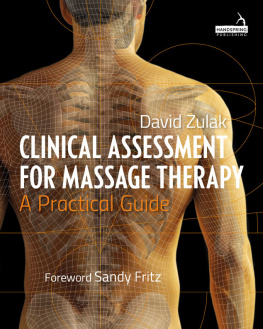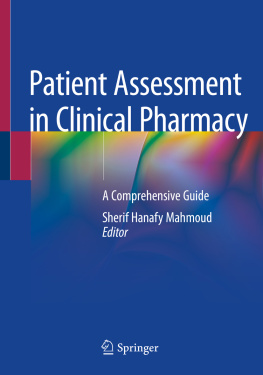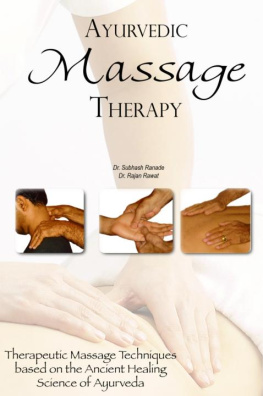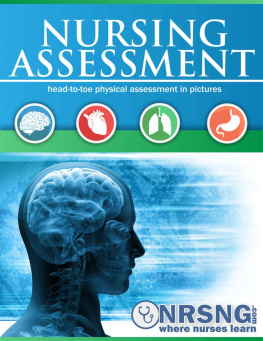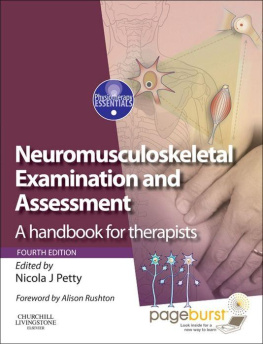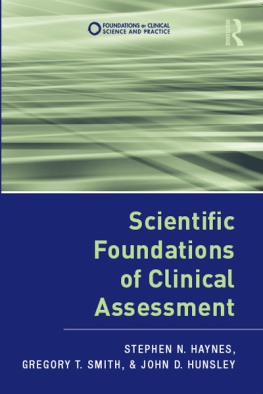Contents
Guide
CLINICAL ASSESSMENT FOR MASSAGE THERAPY



HANDSPRING PUBLISHING LIMITED
The Old Manse, Fountainhall,
Pencaitland, East Lothian
EH34 5EY, Scotland
Tel: +44 1875 341 859
Website: www.handspringpublishing.com
First published 2018 in the United Kingdom by Handspring Publishing
Copyright Handspring Publishing 2018
All rights reserved. No parts of this publication may be reproduced or transmitted in any form or by any means, electronic or mechanical, including photocopying, recording, or any information storage and retrieval system, without either the prior written permission of the publisher or a licence permitting restricted copying in the United Kingdom issued by the Copyright Licensing Agency Ltd, Saffron House, 610 Kirby Street, London EC1N 8TS.
The right of David Zulak to be identified as the Author of this text has been asserted in accordance with the Copyright, Designs and Patents Acts 1988.
ISBN 978-1-909141-37-7
British Library Cataloguing in Publication Data
A catalogue record for this book is available from the British Library
Library of Congress Cataloguing in Publication Data
A catalog record for this book is available from the Library of Congress
Notice
Neither the Publisher nor the Authors assume any responsibility for any loss or injury and/or damage to persons or property arising out of or relating to any use of the material contained in this book. It is the responsibility of the treating practitioner, relying on independent expertise and knowledge of the patient, to determine the best treatment and method of application for the patient.
Commissioning Editor Mary Law
Project Manager Morven Dean
Copy-editor Stephanie Pickering
Designer Bruce Hogarth
Indexer Aptara, India
Typesetter DSM, India
Printer Bell and Bain, UK
The
Publishers
policy is to use
paper manufactured
from sustainable forests

Dedication
This textbook is dedicated to my wife, Anne Wilson.
Without her support, love and inspiring example of determination, this book would never have seen the light of day.
It is also dedicated to my extraordinary children, Katie and James, for their sustaining love.
Contents
To work with clients from an outcome goal process, it is necessary to be able to gather information about the clients health status. Physical assessment is an important part of the information gathering process. The client history and outcome goals will guide what physical assessments to perform. Physical assessment can also help provide screening for referral, especially if joint dysfunction is suspected. This book provides the information to learn a variety of assessment skills to better understand the condition of the various types of soft tissue and joints that may be related to the client symptoms.
Assessment seeks to understand not change. Assessment asks questions and interprets the responses to those questions. Asking a client to move a joint or hold against resistance are examples of the questions. The responses can be normal function, limited function, function with effort and so forth. We will not understand the client status without asking the questions first.
The assessment process is a skill. Too quickly we jump to interventions with intention to change function. We press on this and pull on that before we understand the bigger picture. I often identify massage therapists using too much intervention and not enough assessment. This text is focused on assessment. While guidance is provided toward choices for appropriate intervention, an intervention is only used once assessment identifies the conditions for a specific, unique individual and what outcomes for treatment are desired.
There are many types of physical assessment procedures. For the massage therapist, the ones used need to be effectively integrated into the massage session process. There is an expectation about the massage session by most clients. They want to lie on the table and be touched in a therapeutic way, experiencing a sense of satisfying pressure and movement. There is value in the general massage application. Performing too many physical assessment tests will not feel like a massage to the client. You need to intelligently pick and choose assessment methods. This text provides procedures to help you learn about your client. Remember all aspects of the massage session are assessment if you approach your client with mindful focus and pay attention to their response to the massage application.
Sandy Fritz BS, MS, LMT Board Certified, NCBTMB
Founder, Owner and Head Instructor
Health Enrichment Center
School of Therapeutic Massage Lapeer MI
March 2018
There are many people to thank for helping me make this book become a reality. I will begin by thanking all my students, who over the years taught me so much, who were so patient with me, and who encouraged me to pursue this project.
A large share of gratitude goes to Johan Overzet. Since meeting at the Sutherland-Chan School of Massage and Teaching Clinic in 1992, we have studied together, practiced our craft, debated, and advanced together. We both attended osteopathic courses together in Canada and helped each other survive the experience and be better manual therapists for it. The results of many of our debates over the years are scattered through this book. Johan has always been honest with me, whether in approval or criticism. That, above all, proves he is the truest of friends.
I would like to thank Anne Wilson MA for her invaluable editing skills over these many years. Also, I am indebted to Jackie Guanzon RMT and Ashley Marcos RMT for their efforts in serving as proofreaders for various parts of the book. Jackie also served as the principal model throughout the book, assisted by Antonella Licata, Darryl Hoogendam RMT, Justin Doherty RMT, Katrina Raney RMT, and Sara Hanson RMT.
I am grateful to my instructors at Sutherland-Chan School of Massage Therapy for their dedication to the profession and to their students. I wish to thank Debra Curties RMT and Trish Dryden MEd, RMT for their support and encouragement in my first attempts at teaching, which also occurred at Sutherland-Chan. My first co-teacher, the late Earl ONeal PhD, RMT, who so generously shared his wealth of experience with me, is fondly remembered.
I am honored that Sandy Fritz MS, NCTMB has written the Foreword for this book. I have been inspired by her dedication to the profession of massage therapy, especially for her efforts over many years to improve the quality of education available for students and practitioners.
Of course, I need to thank those at Handspring Publishing who worked to bring this to print, including the publishers Andrew Stevenson and Mary Law. I especially wish to thank Mary for her kind support, advice and gentle reminders about deadlines over the last few years. Also, thanks go to Morven Dean (Project Manager), Bruce Hogarth (Designer), Stephanie Pickering (Copy Editor) and Hilary Brown (Marketing Manager); and to all those at Handspring Publishing who had a hand in producing this book.
Next page
